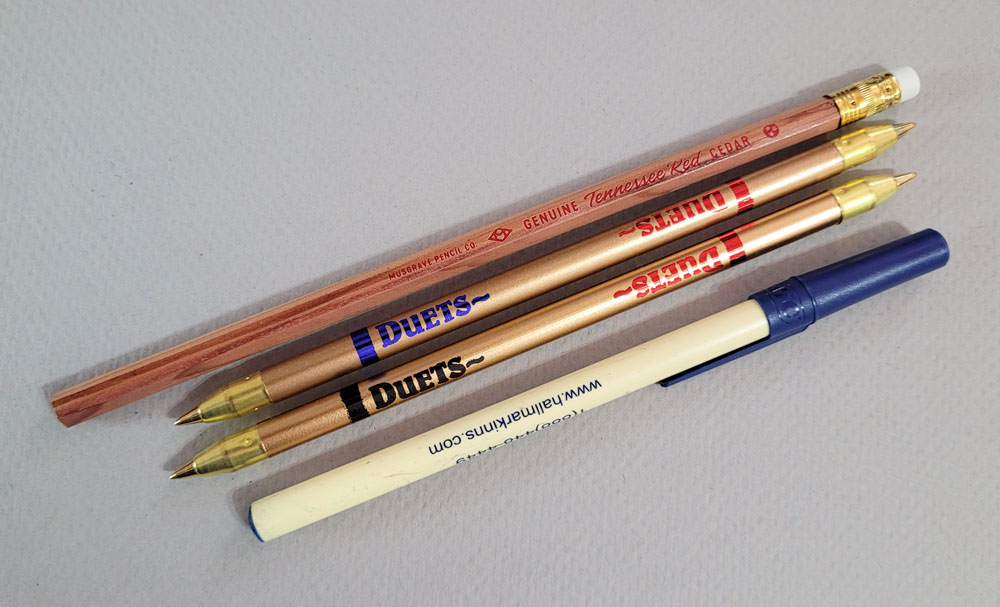Review by Tina Koyama
Musgrave Pencil Co. of Shelbyville, Tennessee, is one of very few remaining pencil manufacturers in the US. Operating since 1916, it’s still family-owned. As such, I feel an affinity for the company’s history and heritage, though not always its products. For example, the gorgeous Tennessee Red pencils in their cedar box smell scrumptious, and often I slide open the box just to inhale deeply. The pencils, however, are better for sniffing than writing.
Clicking around Musgrave’s site one day, I did a double-take: Shown among the many pencils were two Duets Pens – bicolor ballpoint pens! What? A red/blue pairing and a red/black one (12/$11.25). Just like Ana does, I have a collection of red/blue editing pencils as well as a more general obsession with all bicolor pencils. But a bicolor ballpoint pen? That’s something I don’t see every day! And here’s what made me do a triple-take: The pens are “cedar wood cased.” Whaaaaat??
Although I didn’t really need a dozen of each color combo, which is the only way they are sold, it was a small price to satisfy my curiosity, now doubly piqued.
Before I get to the Duets, I wanted to mention that, as has been the case every time I’ve ordered from Musgrave, I received a sleeve of two of the company’s most popular pencils as a gift. It’s fun to get anything free with purchase, and these sleeved pencils are an especially nice touch that befits the company’s long heritage.

Maybe because I use Bic Cristal and Stic ballpoints, I was surprised that the Duets came without caps. I suppose they are more pencil-like without caps, though. Caplessness notwithstanding, the Duets points do somewhat resemble Bics.


The pen body is shorter than an unsharpened pencil and slightly longer than a Stic. It weighs about the same as the Stic and is lighter weight than a standard wood pencil. As for that cedar wood casing, I was initially perplexed. At first glance, it looks and feels like plastic. When I found a rough spot next to the “ferrule” (I don’t know what else to call the collar that connects the barrel with the pen point), I gouged into it with a fingernail, and it was easy to do – it felt like soft wood. On closer inspection, I thought I could see woodgrain beneath the thin metallic-colored paint (which I daresay is the same color as Blackwing’s latest Volume 200, though not as glossy). Hmmm, it doesn’t smell like cedar at all.



There’s only one way to find out for sure, right?

Yup, it’s real wood – splinters and all – and when I cut it open, I smelled cedar! Does anyone else think it’s odd to make a ballpoint pen out of cedar, then cover the cedar with paint?
Now I’ll get to the critical part – the ink. For writing, I tend to prefer Japanese “hybrid” inks like Uni Jetstream that flows smoothly and flawlessly. But I also use ballpoint ink as a drawing medium, and for that, my hands-down favorite is the lowly Bic, which contains an oily, viscous ink that layers beautifully like graphite. Upon initial scribbles, I was pleasantly surprised to find the Duets ink similar to Bic’s in consistency.
That is, the Duets were similar if they flowed at all. Specifically, the red side – in both red/blue and red/black – would not flow at all in nearly half the two dozen I purchased. (Ah, so perhaps that’s the reason they are sold by the dozen and not individually: With 12 in hand, you have a better chance of getting a few pens with two working sides.) I don’t mean hard starts; I mean non-starts. Zero ink flow. I wore holes into the paper trying to get the red ink to flow. The blue and black sides flowed acceptably in all pens, especially after scribbling a while.

I managed to find one of each color combo that worked on both ends, so I made a couple of test sketches. The good news is that the ink is very much like Bic from a drawing perspective: I can build up layers of ink in the same way I do with graphite or colored pencils. However, the red is not as smooth as the blue or black and tends to blob more. Clearly, there’s something wrong with the red ink supply in these pens.
Though it’s strangely ironic coming from a pencil maker, I give Musgrave credit for this unique bicolor ballpoint pen (with an even more strangely ironic cedar barrel that looks like plastic). Unfortunately, it loses many points for that faulty red ink.

DISCLAIMER: Some items included in this review were provided free of charge for the purpose of review. Some items were purchased with funds from our amazing Patrons. You can help support this blog by joining our Patreon. Please see the About page for more details.
 Tina Koyama is an urban sketcher in Seattle. Her blog is Fueled by Clouds & Coffee, and you can follow her on Instagram as Miatagrrl.
Tina Koyama is an urban sketcher in Seattle. Her blog is Fueled by Clouds & Coffee, and you can follow her on Instagram as Miatagrrl.

